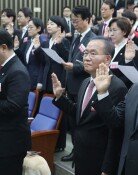The Kaema Plateau and Mount Baekdu in North Korea
The Kaema Plateau and Mount Baekdu in North Korea
Posted May. 19, 2018 07:22,
Updated May. 19, 2018 07:22

Amid an amicable mood building on the Korean Peninsula, some South Korean people including politicians have expressed their hopes that a day will soon arrive when North Korea opens up its tourism industry and they will be able to go trekking to the Kaema Plateau in North Korea. “Don’t count your chickens before they hatch,” others responded to such comments.
The development of tourism for foreign visitors is an area that North Korean leader Kim Jong Un, who was educated in Switzerland, has particularly focused on, differentiating himself from his father and grandfather. Switzerland is the one of the top destinations for global tourists, and railroads are the foundation of the country’s booming tourism industry. Will North Korea be able to join the ranks of the most popular tourist countries? Experts predict that the hermit kingdom has rich potential, but even if the tourism market is opened, tours are likely to be made only restrictedly due to transportation, accommodation and safety issues.
The Kaema Plateau covers the eastern coast from the Mount Kumgang special tourism zone (designated in 2002) to Wonsan, located 107 kilometers to the north. Wonsan has long been recognized as a scenic spot with its vast sandy beach named “Myeongsasipri.” Also, the opposite (west) side covered by the dense forests of Masikryong mountains makes the city even more attractive as a tourist destination, especially during winter when it snows a lot. This is why the Western style ski introduced by Japanese people in 1921 was first brought to this region and a ski resort was built under Kim Jong Un’s direction.
There are two routes to climb Mount Baekdu, one from China and the other from North Korea. What tourists get to see up on the mountain are completely different depending on the routes they use, so the scenery of Mount Baekdu seen from the North Korean side still evokes curiosity for even those who have hiked the mountain in China. If the route is opened, what will draw the most attention would be whether the country will allow the public to approach near the Heaven Lake. In North Korea, the Heaven Lake has been considered sacred and people were not allowed to even touch the water. Still, there is a possibility this will change. In September 2000, following the June 15 South-North Korea Joint Declaration, the North permitted South Korean envoys to move near the crater lake and even ride a motor boat.
Yet, there is a prerequisite to taking a trip to Mount Baekdu: the expansion of facilities at Samjiyon Airport. In 2005, the South Korean government supplied the North with asphalt pitch worth 4.9 billion won on two occasions for the purpose of repairing the airport’s runways. It was ahead of a planned trial tour according to the July 14 agreement in 2007. However, with South Korean tourist named Park Wang-ja shot by a North Korean soldier at the Mount Kumgang resort in 2008, the trial tour could not take place. The Kaema Plateau is located at an altitude of 1,400 meters, which is equivalent to the top of Mount Balwang (1,459 meters), which has the Yongpyong Resort.
Mount Baekdu is a huge volcano that rose over the Kaema Plateau, and the name “Baekdu,” which means “white head,” came from the mountain’s tiptop that is white as if covered with snow. What makes the mountain’s top dazzling white is not snow but pumice from the time of eruption, and it is another thing that tourists cannot approach through the Chinese route.
summer@donga.com







